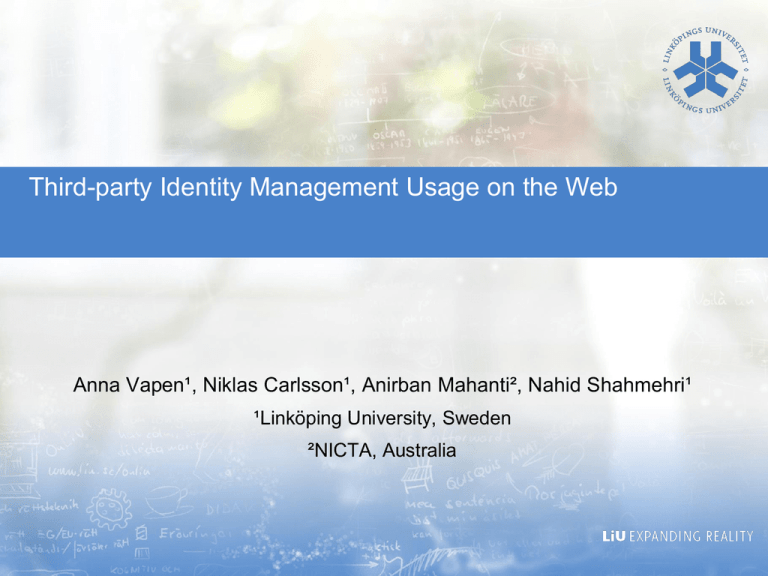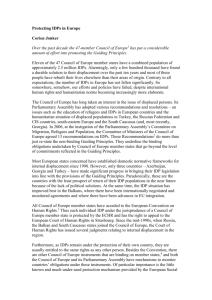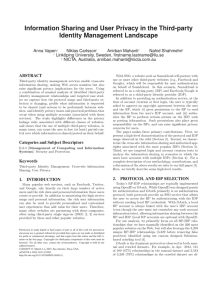Third-party Identity Management Usage on the Web ¹Linköping University, Sweden
advertisement

Third-party Identity Management Usage on the Web Anna Vapen¹, Niklas Carlsson¹, Anirban Mahanti², Nahid Shahmehri¹ ¹Linköping University, Sweden ²NICTA, Australia Third-party Web Authentication Web Authentication • Registration with each website • Many passwords to remember Third-party authentication • Use an existing IDP (identity provider) account to access an RP (relying party) • Log in less often; Stronger authentication • Increase personalization opportunities • Share information between websites 2 Motivation • An emerging third-party authentication landscape • Increasing usage of third-party identity providers • Complex, nested relationships between RPs and IDPs • Authorization protocol (OAuth) used for authentication • Applications acting on user’s behalf • Data transfer between parties; Less control over data • IDP selection • Privacy implications 3 Contributions • Novel Selenium-based data collection methodology • Identification and validation of RP-IDP relationships • Popularity-based logarithmic sampling technique • Characterization of identified RP-IDP relationships • Impact on IDP selection of RP characteristics • Comparison to third-party content-delivery relationships 4 Methodology (1) • Popularity-based logarithmic sampling • 80,000 points uniformly on a logarithmic range • Power-law distribution • Capturing data from different popularity segments 1 million most popular websites 5 Sampled websites Methodology (2) • Selenium-based crawling and relationship identification • Able to process Web 2.0 sites with interactive elements • Low number of false positives • Validation with semi-manual classification and text-matching 1 million most popular websites 6 Sampled websites Collected Data 1,6 terabyte analyzed data 25 million analyzed links WHOIS, server location and audience location 35,620 sampled sites 3,329 unique relationships 50 IDPs and 1,865 RPs Total site size and number of links and objects 7 IDP Usage • More than 75% of the RPs are served by 5% of the IDPs • RPs tend to select popular sites as IDPs • Only 15 of the 44 IDPs outside top 10 on Alexa serve more than 10 sampled RPs 75% of RPs served by 5% of IDPs 8 Top IDPs IDP rank Alexa rank IDP Protocol Number of IDP relationships 1 2 Facebook.com Oauth 1293 2 10 Twitter.com OAuth 378 3 9 QQ.com OAuth 278 4 1 Google.com Oauth / OpenID 250 5 4 Yahoo.com Oauth / OpenID 141 6 16 Sina.com.cn Oauth 127 7 - OpenID field OpenID 87 8 4173 Vkontakte.ru Oauth 73 9 25 Weibo.com Oauth 64 10 12 Linkedin.com Oauth 63 ** * ** * Domain change to vk.com 9 Login with any OpenID provider ** Authentication with Sina.com.cn redirects to Weibo.com Top IDPs IDP rank Alexa rank IDP Protocol Number of IDP relationships 1 2 Facebook.com Oauth 1293 2 10 Twitter.com OAuth 378 3 9 QQ.com OAuth 278 4 1 Google.com Oauth / OpenID 250 5 4 Yahoo.com Oauth / OpenID 141 6 16 Sina.com.cn Oauth 127 7 - OpenID field OpenID 87 8 4173 Vkontakte.ru Oauth 73 9 25 Weibo.com Oauth 64 10 12 Linkedin.com Oauth 63 ** * ** * Domain change to vk.com 10 Social networks (except no. 7) Login with any OpenID provider ** Authentication with Sina.com.cn redirects to Weibo.com IDP Selection • Popular sites as IDPs, instead of specialized IDPs Popular sites with • Lots of existing users • Personal information Specialized IDPs with stronger authentication methods 11 Number of IDPs per sampled RP IDP widgets providing a pre-selected large set of IDPs Estimated weighted average: < 3 IDPs / RP 12 IDPs per RP Based on Popularity Number of IDPs per RP 4 3.5 3 > 10^6 2.5 (10^5 - 10^6]3 2 (10^4 - 10^5] 1.5 (10^3- 10^4] 1 (10^2 - 10^3] (10 - 10^2] 0.5 [1 - 10] 0 [1 - 10] (10 - 10^2] (10^2 10^3] (10^310^4] (10^4 10^5] (10^5 10^6]3 Alexa site rank of RPs Breakdown of the average number of IDPs selected per RP and popularity segment 13 Comparison with Content Services • Content: scripts, images and other third-party objects • IDPs much more popular sites than content providers 14 Service-based Analysis 200 most popular websites Manual classification Using social IDPs: file sharing, info Likely to be RPs Likely to be IDPs; Many RPs in this category News File sharing Video Tech Early adopters, using several IDPs 15 Info Commerce Social/portal Ads CDN Using IDPs from same category: tech, commerce Cultural and Geographical Analysis • North American and Chinese RPs use local IDPs to a large extent • Content delivery usage less biased to local providers North America Europe China Russia Asia (all) Identity management Content delivery 16 North America China Asia (rest) Europe Russia Other Summary and Conclusions • Large-scale characterization of third-party Web authentication • Novel data collection methodology with popularity-based sampling • Few large third-parties serve many websites • Comparison with content sharing • IDP selection much more biased • Risk for privacy leaks 17 • Few large third-parties handling a lot of information • The most popular IDPs are using protocols not adapted for strong authentication




